This week, guest bloggers Kyle O’Carroll, Daniel Kruglyak, and Vikash Tewari are taking over the Climate Change Fork blog. We are undergraduate students at Brooklyn College, class of 2020. We are all majoring in physics with minors in biochemistry, chemistry, and chemistry respectively. The focus of our blog is to evaluate nationwide electrical efficiency and to examine how different forms of energy are used to produce electricity. We will discuss how these energy sources have changed over time.
Electricity Production
Before we get into the complexities of our discussion, it is necessary for us to present some of the definitions which we will build upon throughout this blog. The most critical aspect to understand for our discussion is the difference between electricity and energy. For our purposes, we will define energy in terms of the various sources which are used to generate electricity.
Different energy sources include coal, oil, natural gas, hydroelectric power, solar, biomass, nuclear, geothermal, and wind. These can largely be broken into two different categories: renewable and nonrenewable. We take a renewable energy source to mean any method of electricity production which uses an element of our natural environment in a way that does not decrease its supply as a result of that production. Renewable sources include hydroelectric power, solar, biomass, geothermal, and wind energy. On the other hand, nonrenewable sources consist of any electricity sources which have a finite quantity and can decrease with continued use. These nonrenewable sources include coal, oil, natural gas, and nuclear energy. While nuclear energy can technically be classified as either renewable or nonrenewable, depending on the definition used, we will classify it here as nonrenewable. This is because the uranium used in nuclear energy plants to create electricity depletes over time.
It is important to note that renewable and nonrenewable sources have substantial differences both in their impacts on the environment and in their carbon production. All renewable sources produce negligible carbon dioxide emissions, whereas nonrenewable sources—with the exception of nuclear energy—create high levels of them. Studies suggest that these carbon emissions contribute to an increase in the global temperature, which in turn contributes to a multitude of global phenomena including droughts, typhoons, hurricanes, the melting of the polar ice caps, rising sea levels, and many other natural cataclysms.
We must recognize that the electricity which we use every day is created by different sources of energy and that they each contribute different amounts of carbon to the atmosphere. Each country and, in America, each state, has different methods of producing the electricity that will be used by the general population. It is useful to identify how different places generate electricity and how that has changed over time. Something as simple as leaving your television on in your home overnight can contribute to the degradation of the environment, depending on how the electricity which powers the television was generated. Recognizing the effects we have on the environment—even when carrying out everyday processes—is a vital step in working towards creating a cleaner future. We need to be cognizant of our actions so we can do our part to help mitigate climate change.
Many countries came together under the 2016 Paris Climate Agreement, promising to make a push to cut emissions by 2025. Countries such as Sweden, Costa Rica, Nicaragua, Scotland, and Germany have shifted to almost 100% renewable energy to produce their electricity (Council, 2019). Shifting to non-carbon-emitting energy sources for production of electricity is one major way that a country can help halt emissions and reduce the effects of global warming. America has not made a complete shift toward renewable energy sources and it is severely hurting the attempt to reach our global emission goals. We should recognize, however, that while America as a whole is not moving towards renewable sources, there are some states which use them almost exclusively to generate their electricity.
Figures 1a and 1b show two examples of outliers in electricity production in the United States from the period of 2001 to 2017. Idaho is one state that leads in clean electricity production; it produced over 80% of its electricity from renewable sources. Hydroelectric power has decreased recently in Idaho due to droughts but the state’s use of wind has increased as a result. Meanwhile, on the other side of the spectrum, West Virginia produces 93% of its energy from coal. In 2015, lobbyists repealed its renewable energy standard which would have required 25% of its electricity to come from renewable sources.
Figures 1a & 1b – These charts show the change in energy production over the years (2001-2017) of Idaho (above) and West Virginia (below)
Local communities in the US need to work towards policies which shift their electricity production. As a whole, America should look to countries like Sweden for inspiration for the coming years and implement nationwide reform to our current policies.
Electrical Efficiency
In order to discuss America’s impact on the climate, we focused on evaluating our country’s efficiency in electricity use as well as the effect of this efficiency on the wellbeing of the planet. We will calculate efficiency as electricity generation versus gross domestic product (GDP). GDP as defined by the Bureau of Economic Analysis is a comprehensive measure of US economic activity. GDP is the value of the goods and services produced in the United States. The growth rate of GDP is the most popular indicator of the nation’s overall economic health. By evaluating electricity generation per GDP, we are able to discuss America’s efficiency of use of generated electricity to promote its economic products. The factor of electricity/GDP correlates to the IPAT equation, where we take:

This equation is critical in the discussion of climate change; it is the primary determining factor of worldwide CO2 production at a given time. The factor (Energy/ GDP) is used for representation of energy intensity and is where we derived our definition of electrical efficiency. To identify the change in America’s efficiency over time, we looked through multiple data sources and compiled graphs which represent the historical trends of the country’s production.
Analysis
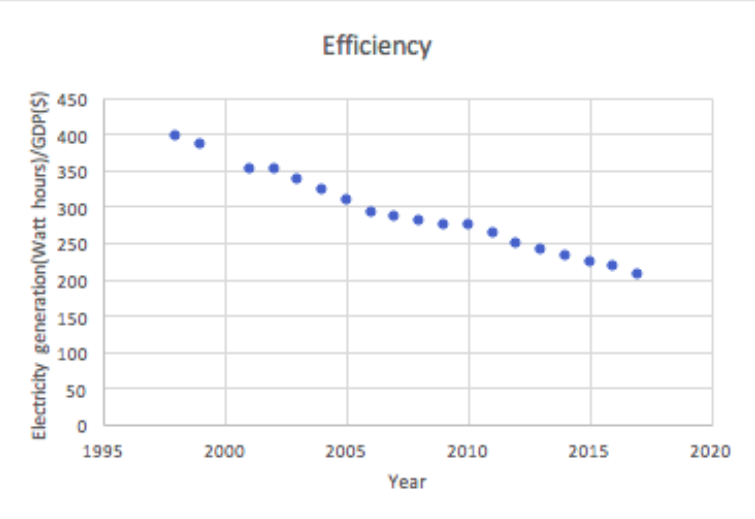 Figure 2 – Ratio of Electricity Generation to GDP in the US, 1998-2017
Figure 2 – Ratio of Electricity Generation to GDP in the US, 1998-2017
(“State Electricity Profiles – EIA,” 2016) & (“GDP- Worldbank,” 2016)
As we can see, the chart displays a negative trend, which implies that the GDP is rising faster than electricity production. We define efficiency in terms of effective use of electricity to produce GDP. The y-axis shows the required amount of watt-hours to produce a dollar in GDP. This means we can produce the same amount of GDP with less electricity. This data shows us that in the last 20 years the efficiency of the United States has increased.
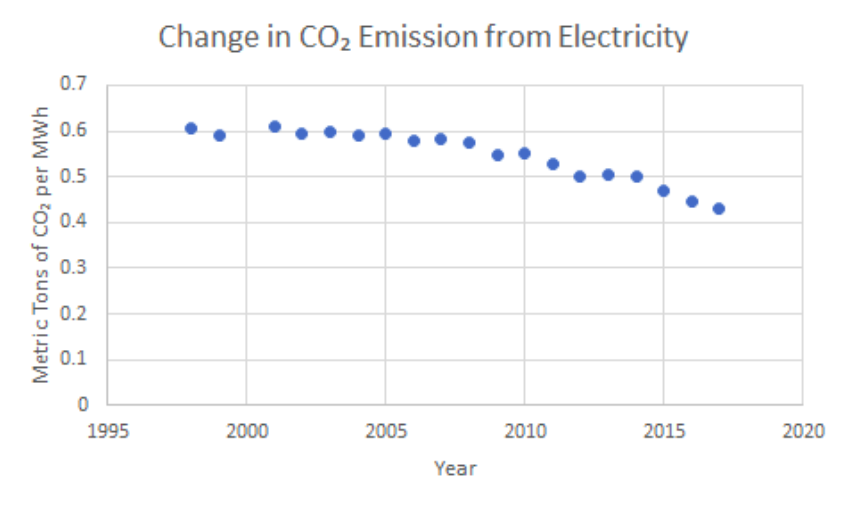 Figure 3 – Ratio of CO2 to Electricity Generation in the US, 1998-2017
Figure 3 – Ratio of CO2 to Electricity Generation in the US, 1998-2017
(“State Electricity Profiles – EIA” 2016) & (“Carbon Dioxide Emissions From Energy Consumption – EIA” 2019)
In plotting the ratio of carbon emissions to electricity generation over time we are able to note that there has been an overall negative slope. This indicates that America is moving in the right direction. Over the last 20 years we have decreased the amount of carbon produced in generating the same amount of electricity. This is due to an increase in cleaner energy sources such as renewable energy over the past 2 decades, as shown in the next graph.
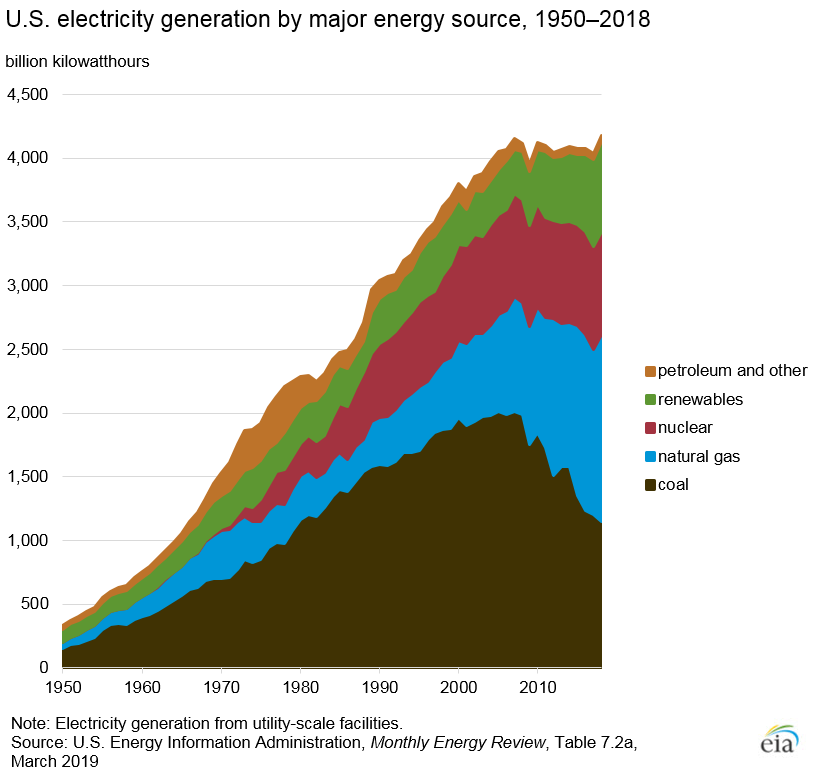 Figure 4 – US electricity generation by major energy source, 1950-2018
Figure 4 – US electricity generation by major energy source, 1950-2018
As we see in the electricity generation by major energy sources in the US, over the last 20 years coal use has decreased and renewable energy sources have seen an increase. This explains why carbon emissions per megawatt-hour production have decreased. Despite recent false claims about wind power causing cancer, wind power is a great source of clean, renewable energy.
Conclusion
Many countries are making the effort to move towards cleaner energy and America should continue to follow suit. Throughout recent years, America has been slowly reducing carbon emissions by producing electricity using cleaner energy sources. However, these changes have been too slow and insignificant. While our data shows that America has moved towards cleaner electricity production and has become more efficient, we should not sit back and allow the government to be pleased with these minor successes. It will take a long time to completely switch to clean/renewable energy altogether so while clean electricity production is a good start, large-scale policy changes need to be made in all aspects of our society. In order to reach the goals set out in the Paris Climate Agreement, and for the good of our planet, we need to continue to make bold strides to reduce our carbon emissions and protect our planet.
References
- Council, C. (2019, January 14). “11 countries leading the charge on renewable energy – Climate Council.” Retrieved from Climate Council website: https://www.climatecouncil.org.au/11-countries-leading-the-charge-on-renewable-energy/
- Electricity in the United States – Energy Explained, Your Guide To Understanding Energy – Energy Information Administration. (2019). Retrieved from EIA.gov website: https://www.eia.gov/energyexplained/index.php?page=electricity_in_the_united_states
- GDP (current US$) | Data. (2016, December 31). Retrieved from Worldbank.org website: https://data.worldbank.org/indicator/NY.GDP.MKTP.CD?locations=US
- “How to Cut U.S. Emissions Faster? Do What These Countries Are Doing.” (2019, February 13). The New York Times. Retrieved from https://www.nytimes.com/interactive/2019/02/13/climate/cut-us-emissions-with-policies-from-other-countries.html
- Popovich, N. (2018, December 24). “How Does Your State Make Electricity?” The New York Times. Retrieved from https://www.nytimes.com/interactive/2018/12/24/climate/how-electricity-generation-changed-in-your-state.html
- State Electricity Profiles – Energy Information Administration. (2016). Retrieved April 26, 2019, from EIA.gov website: https://www.eia.gov/electricity/state/
- Table 12.6 Carbon Dioxide Emissions From Energy Consumption: Electric Power Sector (Million Metric Tons of Carbon Dioxide). Retrieved from https://www.eia.gov/totalenergy/data/monthly/pdf/sec12_9.pdf

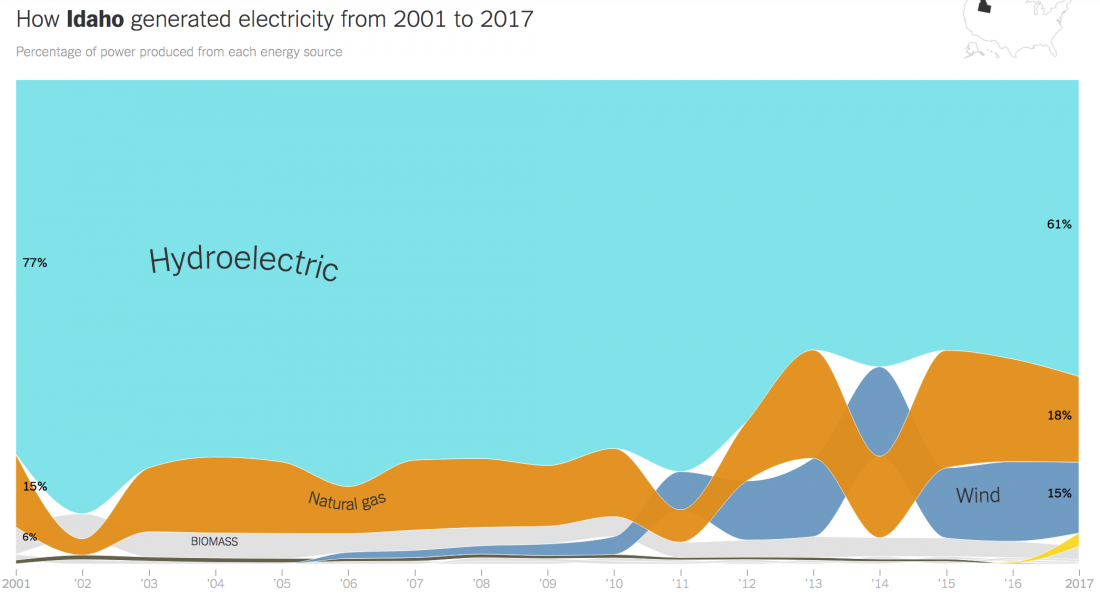
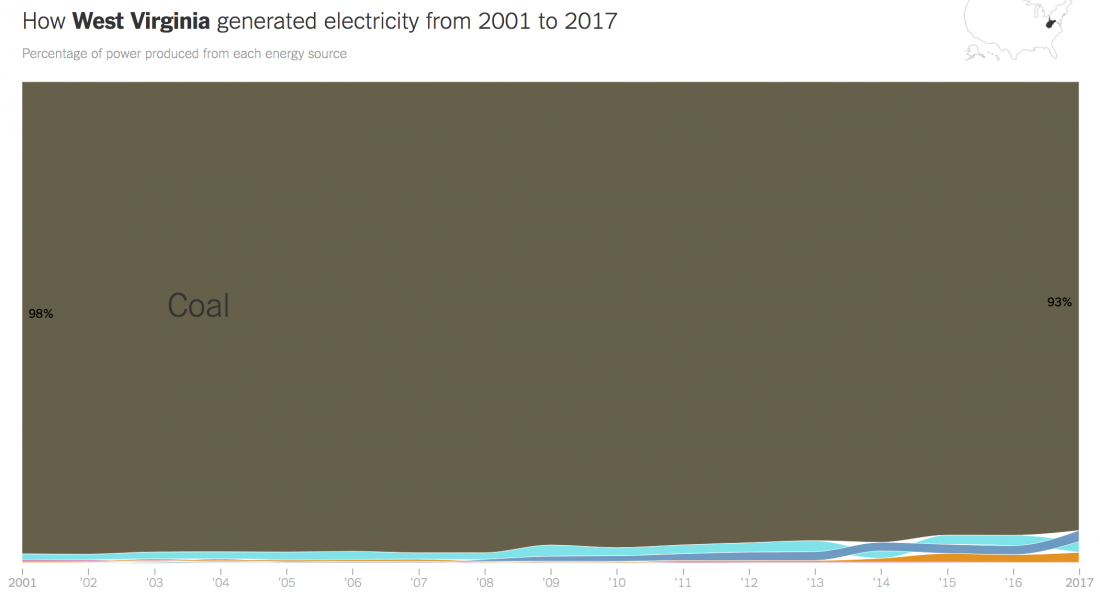
I find it interesting that over 90% of the energy produced in West Virginia is from the use of coal. Reducing our reliance on coal is certainly important, but it is difficult to do in West Virginia when roughly 30,000 residents currently work in the coal industry. How do you suggest West Virginia approaches the task of reducing their reliance on coal without significantly affecting their economy?
There is one major problem involved with the primary solution proposed (switching to renewable energy sources)- environmental impact associated with the actual production process. If we consider the resources used to create the giant rotors and blades for wind generation, the benefit ratio becomes questionable. Additionally, for most of these sources, we would have to store energy to account for peaks in energy usage. If we use batteries (especially the typical batteries used today, which do not last as long as expected, and also have negative environmental effects associated with production), we are given another issue to deal with.
In Kyle’s response, he suggested transitioning to electric vehicles, where again, we have similar problems. Additionally, we simply do not have the infrastructure to support the number of EV’s necessary to create a significant dip in transport-associated carbon emissions. Realistically, our current technology is not yet at the point where we can solve aforementioned issues.
As one of the authors of this post I would just like to respond to a few of the comments made under this post.
Firstly to respond to Nataly Azouly, I do believe that placing restrictions and imposing taxes on less efficient means of electricity generation would be the only effective way to combat the environmental implications that these means of production have. Unfortunately, we can not rely on the good faith of the different businesses to make these changes themselves because often all that is important is maintaining a profit regardless of what the cost to the environment is. One such restriction which has proved to be effective is placing a carbon tax on the different industries. Continually, to address your second point about SUV’s, I do not believe that we can shift the public opinion on what car they should purchase. However, an effective way to combat this would be to insure that all cars manufactured after 2020, SUV’s included, must run on electricity we could combat the impact that these cars have on our environment. However, this would only be effective if there was also a guarantee that all electricity production would be generated from renewable sources nationwide, because without renewable energy production, electric cars just move the problem from one area to another.
To respond to Junfeng Lu, from a global perspective the use of these nonrenewable sources is heading on a trajectory which is not sustainable for future generations, as the years go on and the supplies become less and less available basic principles of economics dictate that the cost will necessarily skyrocket. As the different countries move toward this inevitable occurrence, only those who have prepared for a renewable energy future will be able to prosper without the use of these sources. The countries who have not shifted will inevitably move towards conflict with other nations and it could be the source of a major war over energy. Continually, you are not taking into account the different impacts which the use of these nonrenewable sources have on our environment. The effects of carbon dioxide from our production has links to natural disasters and conflict around the globe that has cost us an unimaginable amount of money over time.
Finally, in response to Haosheng Chen, while every renewable energy source has a particular optimal weather condition where they are the most effective, most locations actually are conductive to the use of at least one of the different means of energy production. Also, the use of different renewable sources simultaneously in diverse climates can be used to supplement one another in the effective production of energy. Finally, renewable energy such as biomass, can be used in any climate no matter how many or how few residents live in the location.
Thank you for all of the comments.
The extraction of renewable energy is regionally restrictive. Most of the renewable energy mining relies on external factors such as geography and weather conditions. For example, wind energy collection needs to be where the air flow is in high condition; the collection of water energy requires environmental resources such as rivers, tides, waves, or currents in the area; geothermal heat, a renewable energy source, can only be collected in areas with geothermal activity. The limitations of renewable energy currently limit its wide application, especially in areas with large populations and high energy bases, because human settlements often mean that there are few environments that are conducive to collect renewable energy. In terms of reducing carbon emissions, human should be attending and promoting new energy, but is it suitable for all regions? Is the energy of new energy enough to serve densely populated areas?
According to EIA estimates, in 1949, oil accounted for 37% of total US energy demand. In the face of high oil prices, the United States has to start mining previously sealed energy. As a consequence of high oil prices, the United States has exploited natural gas on a large scale, so that the United States, as an energy importer, now exports a large amount of natural gas annually as an energy exporter.
Renewable energy sources such as wind and solar have their advantages, but they are not economically comparable to hydrocarbons. The cheapest solar power generation – photovoltaic panels, costs $210, more than three times the cost of burning natural gas.
All in all, renewable energy will remain a small fraction of the global energy mix over the next few decades. For the foreseeable future, hydrocarbons will continue to maintain its current dominance.
Great read. While I do agree that America is moving towards more renewable energy sources, do you think that regulations may need to be put in place to act as a catalyst to reach the point of possibly reversing the adverse effects of climate change? What types of regulations do you think may be most effective?
In addition, the most popular vehicles in the U.S. are S.U.V’s which consume more fuel than the average sedan even though the average family size has decreased. Do you think this wasteful behavior will ever change regardless of where we source our energy?
Hi there! Nowadays personal electric vehicles like bikes, scooters, skateboards and hoverboards are becoming more and more popular. They are very good for commuting to work and city travel. Our site is dedicated to reviews of best electric vehicles models available today, latest news, how-to, advices and much more. Check out our resource https://voltariders.com and we hope it will be helpful. See ya)